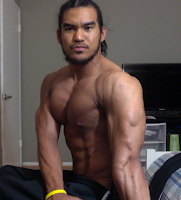 |
| Image 1: "Hey Dude! Those arms come from rolling around in the chair, right? |
The overlooked advantages of training in a wheelchair
I don’t get approached much, but when I do, the majority speculates that I have attained and maintain my physique from pushing my wheelchair around. I assume many people will think that I would expend more energy than the average able body person, and get my fair share of low intensity cardio on a daily basis, due to being and moving in a chair throughout the day, but I am neither sure that this is actually the case (assuming that the aforementioned person is not the average obese couch-potato), nor do I believe that the actual act of moving around in the chair has much of anything to do with my ability to achieve and maintain the physique I have.
In a wheelchair or not, it takes dedication, consistency and balance to be able to achieve the physique you want. I’m no exception to the rule; I still have to diet and train just like everyone else. There’s no magic pill or in my case magic wheelchair, that will get you your results.
With that being said; it was brought to my attention the other day by one of my training partners, that I must really get a good isolation when I do my exercises, just for the fact that I cannot use my legs as a leverage. I paused and thought about it... and yeah, being in a wheelchair does have some training advantages. At least, as far as upper body development and strength are concerned. I think some of the more or less involuntary, since obligatory isolation movements, I do for certain body parts did and still do contribute to my size and strength gains; and what's more, I believe able persons, like you probably are, could benefit from some of them, as well!.
 |
| Image 2: Let's face it guys, THIS can't be the result from rolling around in a wheelchair all day, right? |
- not planting your feet/ legs on the floor and thusly having less leverage and a less solid base, when doing exercises like bench presses
- not curling or pushing (down) from your legs, when you do biceps curls or triceps push-downs
- not being able to bend over like crazy and compensate with your legs, when you did actually sit down to counter exactly those compensatory movements that will hinder you to isolate a certain muscle group as for example during single-arm DB side laterals
The unstable bench is probably not ideal for maximal leverage, but a means to isolate the pecs
Simlarly, on a bench press, people will start arching their backs like crazy (something that obviously will require leg involvement), whenever the load gets to heavy to be lifted properly. In some cases this may be the conscious application of a lifting technique, for 99% of the average gymrats, however, it is simply an instinctive reaction of your body to a load it feels your chest, front delts and triceps (the major muscle groups the flat bench press should activate) won't be able to lift, without a little help from your legs that would put them in a favorable position.
To isolate or not to isolate? Is that a question, at all?
Still, there are benefits in some isolation movements, in my opinion and I think Dr. Andro would have to agree on the fact that the addition of a couple of well-chosen isolation exercises (keep in mind, well-chosen implies that you pick those exercises that work for you, not for Adelfo Cerame, Dr. Andro, or Jay Cutler), when executed with proper form and intensity can provide advanced trainees with the additional accentuated training stimuli neither a "compounds only"- nor the average muscle mag "do every biceps isolation exercise known to man in one single session and repeat that ten times"-workout.
Muscle groups and exercises for isolation
As I have already stated before, your exercise choice will be based mainly on on your personal preferences and goals - with the latter having priority before the former: You would, for example not do tons of hammer DB hammer curls on a preacher bench, if your brachialis was already bigger than your biceps. On the other hand, you would maybe chose standing calf raises on one of those funky machines over doing them freely, if you feel that you are getting a better contraction on the machine.
 |
| Video 1 (click to watch): Here’s a clip of me training rear delts. I don’t really do much for my rear delts, since they are constantly getting hit when I do chins, DB rows, and seated back rows (Adelfo Cerame. 2012). |
- DB side laterals – Gripping one side of my chair, I lean towards the other, so that I can balance the weight of the dumbbell in my hand, then I grip the wheel and do the raises, probably similar to the way you do them. While you could possibly use other muscles than your delts to help yourself out and cheat the DB up, though, the rest of my body is pretty much occupied with keeping me stable so that I get a very decent contraction in my delts - and only in my delts ;-)
- Bent over reverse cable fly’s – I've been through basically every rear delt exercise you can possibly do, I believe, and it was by no means easy to find one that works for me. Either I cannot do them at all, or they don't really isolate the muscle, the way I want them to. What I did find works pretty well, though are the bent over reverse cable fly's (see video 1). And again, not being able to rock to the left or to the side from the legs, must not necessarily be a disadvantage here.

























